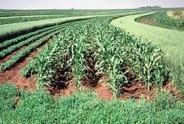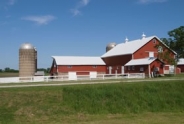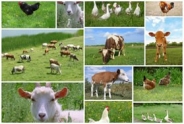Characteristics of Determining Market Readiness of Finished Cattle
Amy Barkley, Team Leader & Livestock Specialist
Southwest New York Dairy, Livestock and Field Crops Program

Regardless of how beef animals are finished, either by grass, grain, or a combination, market weight animals that are sent to the auction or processor should be finished properly. Finishing is the process where an animal is fed a high energy diet to help them put on intramuscular fat, resulting in desirable marbling, which leads to a juicer, more tender, and more flavorful cuts. These desirable quality characteristics result in higher prices at market and a better experience for consumers. Finishing looks different on a purebred steer vs a dairy cross or a heifer vs a steer, but regardless of an animal's genetic background, these animals all have characteristics which indicate that they are ready to go to market.
When judging the readiness of beef cattle, the areas of interest include the tail head, brisket, ribs, flank, width of stance, dewclaws, and rope fat (heifers only). Because of genetic individuality, different animals deposit fat differently, even if they are the same breed. Therefore, the combined score from all of these points should be used to make marketing readiness decisions.
Tail Head:
Tail head fat is deposited on either side of where the tail meets the body, and is one of the most common areas to evaluate for finish. In a finished animal, there will be prominent, palpable amounts of fat present, and it can be seen as lumps of fat on either side of the tail. While evaluating, make sure not to evaluate too high up on or near the tailhead; moving a couple inches away from the attachment of the tail is where the evaluation should be done.
Brisket:
This is another common area to evaluate for finishing. Brisket fat is deposited in the hanging sac of skin at the front of the animal, between the front legs. Depending on the genetics of the animal, the fat deposit can be different sizes. Animals more prone to laying down fat will have a brisket the size of a cantaloupe, while those animals less prone to laying down fat will have one the size of a grapefruit. Knowing what the finish of the breed you are working with looks like will help to make the determination of readiness and will help prevent calling an animal finished that isn't, or over finishing an animal by mistake. That said, if there isn't enough fat deposited in this region, the skin sac will be pointed rather than rounded and not as distended.
Ribs:
The definition of the ribs is another way to determine finish. An appropriate amount of fleshing and fat over the ribs feels equivalent to the back of your hand; you should be just able to feel the individual ribs, but there should be a good cover of fat. Unfinished animals will feel akin to the backs of your fingers, where each rib can be easily distinguished. From a distance, the individual ribs should either be just barely or not visible. The visibility of the ribs will depend on individual genetics and gender of the animal.
Another area that can be evaluated while looking at the ribs are the hooks and pins. If they are prominent and bony, then there is not sufficient fat under the skin to indicate appropriate finishing. These areas will be more rounded on a fattier animal.
Flank:
This is the area between each hind leg and the belly. As the animal accumulates fat, the skin pocket here will as well, and it'll drop away from the body, creating a loose flap. The extra fat also makes this fold of skin thicker. This area is not considered finished if it feels thin, is pulled up close to the body, and is angular in appearance.
Width of Stance:
As an animal accumulates fat, its legs will naturally spread apart to accommodate the extra volume. This will vary widely from animal to animal, so monitoring the width of stance over time can be helpful. Care should be taken to not confuse a widening due to fat and a widening due to the accumulation of muscle.
Dewclaws:
Dewclaws are located at on the rear of the leg at a height equivalent with the top of the hoof. Beef animals which are not yet ready for market will have these sitting more prominently on the surface of the skin. As fat is deposited, the fat around the dewclaws will increase, giving them a "sucked in" appearance as the fat bulges out around them.
Rope Fat:
This fat deposit is unique to heifers and is located from the vaginal area down to the area between the two back legs. In a finished animal, it will have the appearance of a braided rope. When present, it will have the correlation to a low choice quality grade.
While fatting an animal is preferred from a quality perspective, there is a point where an animal can be overfinished. Beef animals deposit fat in the pattern of perirenal (fat around the kidneys) first, followed by intermuscular (between muscle groups), subcutaneous (under the skin, or cap fat) and finally intramuscular (inside muscle, or marbling). While overconditioning will result in more marbling, the tradeoff is that there will be a whole lot of waste from trimming all of the fat other than the intramuscular fat, resulting in a lower yield. This is not preferred by processing plants or direct market consumers buying bulk meats, and will result in a lower price for your animals.
When evaluating the finished characteristics on any animal, it should be noted that some of these characteristics will be less prominent in some breeds vs others. For instance, English breeds such as the angus and Holstein crosses will accumulate more fat in their tailheads and briskets than continental breeds. Knowing the characteristics of the breed you are raising will assist in making management decisions to best prepare your animals for market.
Information in this article was originally shared in the Cornell Small Farms video, "Determining Market Readiness of Finished Cattle" narrated by Dr. Mike Baker, found here: https://www.youtube.com/watch?v=HrF5aCEAI-0&feature=emb_title
Upcoming Events
Boots in the Barn: Cornell Dairy Research Updates
January 13, 2026
January 20, 2026
January 27, 2026
February 3, 2026
February 10, 2026
February 17, 2026
February 24, 2026
Join us for some or all!
Advanced Hoof Health Program
January 15, 2026
Belfast, NY
Who should attend?
- Professional hoof trimmers
- Dairy farm owners or managers in charge of farm foot health
Topics include:
- How to Create a Strategic Trimming Program for your Dairy
- The Latest in Lameness Technology for the Dairy Industry
- Housing and Flooring Design: Its Role in Hoof Care
NY Pork Producers Connection Breakfast - Geneseo
January 17, 2026 : Pork Producers Connection Breakfast - Geneseo
Geneseo, NY
All pork producers are invited to join the New York Pork Producers for a free hot farmer's breakfast, at which they'll catch up on topics including the pork to dairy barn conversion series, NYPP digital campaigns, and 840-RFID tags.
Announcements
No announcements at this time.





